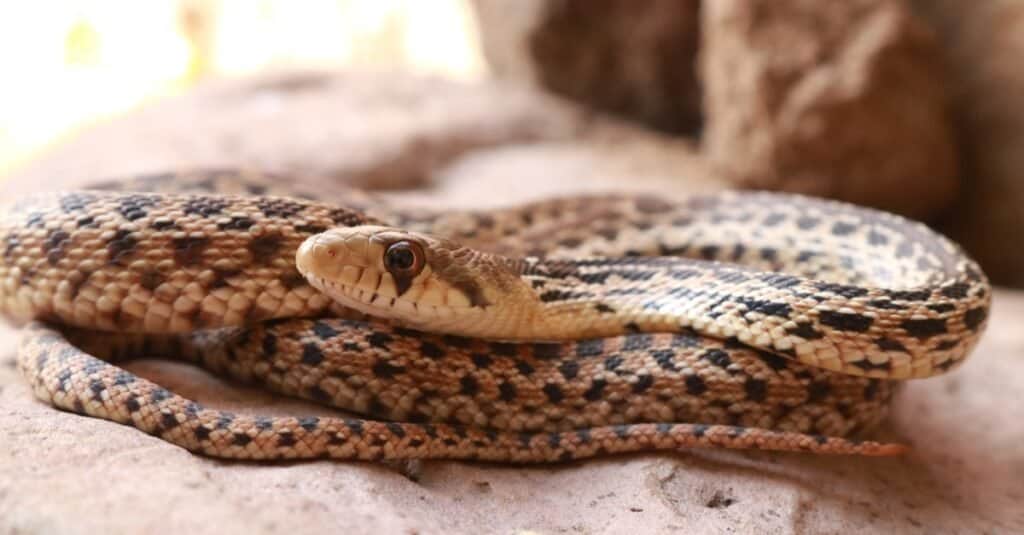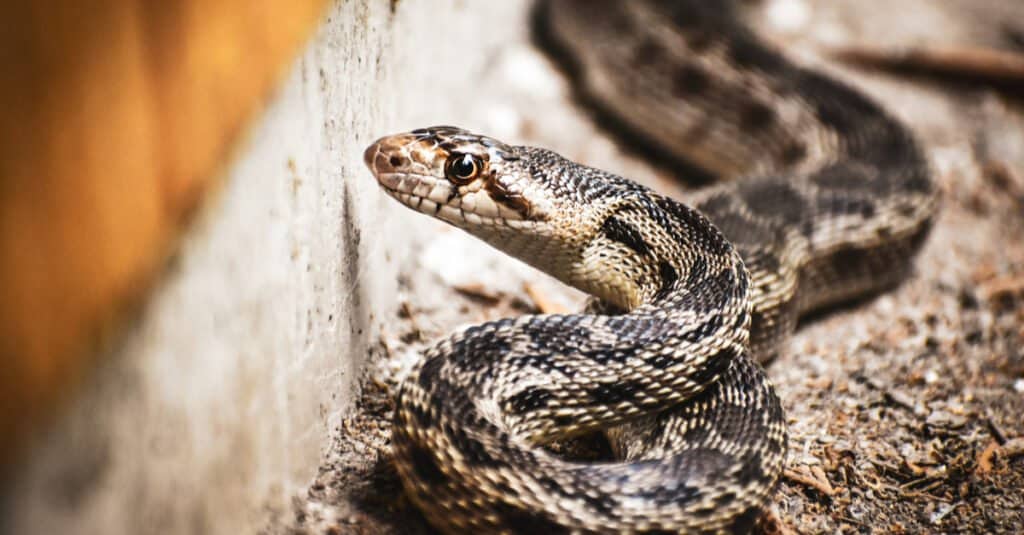
The gopher snake may hiss, vibrate the tail, and strike when annoyed, but it is nonvenomous.
©Creeping Things/Shutterstock.com
America’s gopher snakes are found in western North America, from southern British Columbia to northern Mexico. They live in a variety of environments such as marshes, woodlands, and forests.
San Diego, Coronado Island, Great Basin, San Martin Island, Santa Cruz Island and Bull snake are all subspecies of the Gopher snake. Due to their striking resemblance, they are all frequently confused. So, are gopher snakes poisonous or dangerous? Let’s find out.
Are Gopher Snakes Poisonous?
Strictly speaking, poison refers to something that makes you sick by either eating or absorbing the toxin. Venom is forcibly injected. A good way to remember it is ”If you eat or touch it and you die, it was poisonous. If it bites you and you die, it was venomous.”
Although gopher snakes are nonvenomous, their bites can nonetheless be quite painful. Gopher snakes are constrictors. In other words, they kill their victim by squeezing them. A lot of people have misconceptions about the mechanism of constriction and what it does.
Constrictors tend to crack or crush their prey’s bones when they eat them. Another method is to suffocate the prey by squeezing its lungs so hard that it cannot breathe. Because of the squeezing, the circulatory system is overwhelmed. Ischemia, or the lack of blood flow to the brain, quickly kills the animal.
There are many species of gopher snakes that prey on tiny mammals, birds, and even gophers. They actively hunt for prey, often following small mammals along their runways or burrows.
Are Gopher Snakes Dangerous?
In general, gopher snakes are docile and friendly, and they pose little danger to humans. To defend themselves, they puff themselves up and curl themselves into the iconic strike position of a pit viper, which is a unique protective technique. As a result, Gopher snakes may strike with a closed mouth rather than an open one, using their blunt nose to “warn off” potential predators.
When a gopher snake goes into a full bluff mode, it may be terrifying, but it is more a performance than a serious threat. When they shake their tails, which fools predators into thinking it is a rattlesnake. It’s easiest to do this with a snake that’s lying on dry leaves or stones. When frightened or angry, gopher snakes have been known to hiss loudly as a defense mechanism.
Gopher snakes are typically preyed upon by foxes, red-tailed hawks, and coyotes. As a result of their primary diet of rodents, these gentle snakes are also good for the ecosystem since they keep the rodent population in check.
What Do Gopher Snakes Look Like?

Gopher
snakes have yellowish to pale brown
backs and can measure between three and eight feet.
©Cedar Dobson/Shutterstock.com
Gopher snakes are big, powerful snakes that can grow up to eight feet long. Their backs are typically yellowish to pale brown with big deep brown/black patches and smaller dark markings. Gopher snakes’ eyes are much larger compared to other snakes of the same size. They have snakes have huge heads and thin necks. They frequently have two dark lines around their eyes from the top of their heads.
Can You Keep A Gopher Snake As A Pet?
Gopher snakes are excellent pets for novices and youngsters as they are fascinating to watch, and relatively simple to oversee. They are calm, chill, and rarely bite. Here are some tips if you choose to get a gopher snake as a pet…
Lighting and Temperature
No special temperature or humidity needs to make gopher snakes easy to care for. This is a significant bonus if you don’t want to deal with the costs of special bulbs and fittings.
They do need temperatures of 75 °F at night and 85°F during the day. A “hot spot” of 90-95 degrees on one side of the cage is also recommended.
Using an under-tank heating mat and a thermostat helps attain these temps. Make sure to get one made for reptiles.
Spacious Terrarium
Gopher snakes are active snakes, but not quite as intense as a cornsnake. Even so, they need quite a bit of space! A 10-gallon terrarium is sufficient for babies, but a 50-gallon terrarium is required for adults.
Provide a location to hide and a variety of objects to climb and play on. This is good for the snake’s health, and it’s fun to watch it crawl around and examine its surroundings.
Food and Water
Rodents are what your gopher snake will eat. They will only require feeding on average once every seven days. This is especially useful if you have a hectic schedule. Frozen mice that have been thawed are the primary food source for these predators. Water is also a necessity. Snakes need to drink enough water to keep healthy.
Commitment
Commitment is key when keeping a pet gopher snake. They can survive for up to 15 years in the wild, and in captivity, they have been reported to live up to 33 years.
Bottom line, it’s important to do some research on how to properly care for an animal before you get one, whether it’s a gopher snake or anything else. There is no need to be an expert to keep one, but some know-how is essential.
The photo featured at the top of this post is © Cedar Dobson/Shutterstock.com
Discover the "Monster" Snake 5X Bigger than an Anaconda
Every day A-Z Animals sends out some of the most incredible facts in the world from our free newsletter. Want to discover the 10 most beautiful snakes in the world, a "snake island" where you're never more than 3 feet from danger, or a "monster" snake 5X larger than an anaconda? Then sign up right now and you'll start receiving our daily newsletter absolutely free.
Thank you for reading! Have some feedback for us? Contact the AZ Animals editorial team.






